Music in Hamilton’s Entertainment Hub: A Site Analysis of Che Burrito and Lounge
Site Analysis
Venue: Che Burrito and Lounge
Location: 38 Hess St. South, Hamilton
Description of the Site:
As a more relaxed burrito bar by day, and a popular dance spot by night, Che Burrito Bar and Lounge has made its mark as one of the most iconic alternative venues on the Hamilton Scene. It is located right at the top of the street in Hamilton’s entertainment district – Hess Village. Che’s resident Buggin Out DJ’s on Saturday nights are connoisseurs of the turntables, spinning tracks that never fail to get the crowd in motion. Playing a diverse range of music that sets it apart from other bars in Hess Village, Che’s eclectic music mix of throwbacks, indie-rock jams, hip hop, and electronic beats has become emblematic of its unique character. The space is furnished with unusual décor for a bar; complete with church pews to dance on, newspaper clippings about Che Guevara as wallpaper, and stained glass windows above the DJ booth. Che is a smaller venue, with just one bar counter, a few wooden benches and tables for sitting, a small patio outside, and a large, centrally-located space for dancing. As revolutionary as its namesake, Che has revitalized the bar scene in Hamilton by establishing a venue that breaks the mold. This accomplishment can be largely attributed to its distinct and diversified musical selection, which brings together all different types of people with different musical tastes. Always unique and exciting, Che has become one of my favourite places to go in Hamilton.
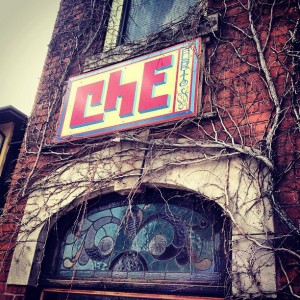
A portion of Che’s exterior.
Photo used with permission from Che Burrito and Lounge, taken from https://www.facebook.com/photo.php?fbid=571420609557475&set=a.553045444728325.1073741828.129787013720839&type=1&theater
Historical Overview:
Although 38 Hess St. South has been a site of musical influence for less than a decade, it has existed throughout many urban transformations, which have lent to the gradual formation of Hamilton’s entertainment hub – Hess Village. Geographically, Hess Village is located in the heart of downtown Hamilton. It includes a length of Hess Street, between King St. West and Main St. West, and George Street, between Hess and Caroline (thespec.com, 2013.) Although now a burgeoning center for nightlife, this was not always the case. Hess Street, and similarly Hess Village, were named after Peter Hess, a proud Hamiltonian from 1779 to 1855 (thespec.com, 2013.) Peter Hess was the original landowner, whose property extended below the escarpment between Queen and Bay streets (thespec.com, 2013.) Peter became an important historical figure in Hamilton as an original stockholder of the Gore Bank, which was one of the first in the area, and which was located directly on his property (thespec.com, 2013.) The area, now known as Hess Village, is a historic landmark of Hamilton, filled with stately Victorian mansions and cobblestone walkways. Most of these old mansions were built around the turn of the century, and served as housing prior to their restoration in the 1970s (McLorn, n.d.) Since its quaint past as a location mainly filled with houses and some small businesses, the village has come a long way. The area underwent a radical transformation in the 1970s, which preserved the historic homes so emblematic of the village’s unique charm.
Hess Village is the birthchild of Hamilton resident and businessman Jim Swansborough (McLorn, n.d.) In the late 1960s, Hess Street and the surrounding area was exceptionally run down and on the verge of being completely demolished to accommodate for new high-rise apartment buildings (McLorn, n.d.) In an attempt to preserve the historical character of the area, and save it from an urban renewal project that would have likely plowed away the stately Victorian homes, Jim began an enormously costly personal project to revitalize the area (McLorn, n.d.) Jim’s creativity and love for history enabled him to envision a brighter future for the region; Jim saw the stately Victorian homes of Hess as an opportunity to create another shopping district similar to Toronto’s Yorkville (McLorn, n.d.) The restoration project began in 1971, in which each building in the Hess area was gradually and carefully renovated (McLorn, n.d.) Although the cost was tremendous, Jim was determined to create an authentic Victorian look and considerable efforts were taken to ensure the interiors and exteriors were restored to their original form, creating an authentic aesthetic appeal (McLorn, n.d.) Eventually, Jim’s personal project garnered the support of the city, and Hess Village was gradually formed (McLorn, n.d.) The area became known as the Hess Village Mall, a successful simulacrum of Toronto’s Yorkville, created through the eyes of Mr. Swansborough (McLorn, n.d.) Unlike most transformative urban undertakings, however, this village didn’t start with a large-scale development company, or in-depth feasibility studies (McLorn, n.d.) Rather, it was Jim Swansborough’s personal mission, and his creative insight that allowed for the preservation of the Victorian mansions along Hess and George streets, and the formation of the area known as Hess Village today.
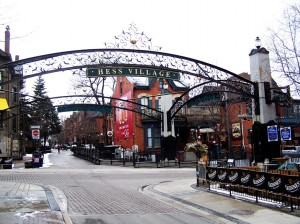
Entry sign to Hamilton’s Hess Village.
Photo taken from http://www.kubesteel.com/html/kubes_steel_aess_ornamental_inlay_hess_village.jpg
Nevertheless, unlike the boutiques and small businesses which lined the village until about a decade ago, Hess Village is now an entertainment hub, “catering largely to a young clientele who do not begin arriving until 10 or 11 p.m. and stay until the bars close at 2 a.m.” (thespec.com, 2007.) This second transformation of the area from a shopping district to an entertainment district began in the late 1980s, as pubs and restaurants began to dominate what was formerly known as Hess Village Mall (Davidson, 1989.) The future of Hess was envisioned as a showcase of music, art, and entertainment (Davidson, 1989.) However, what eventually took over was not exactly what the city had in mind for a showcase of Hamilton’s finest entertainment (Whitwell, 2008.)
Hess Village has since become a place for young adults to socialize, drink, and dance the night away. Within the last five years, the village has undergone another significant change (Whitwell, 2008.) Whitwell (2008) describes this transformation as one from “pub to club.” Although Hess Village was previously Hamilton’s home to new musical talent, the area has has “taken on a louder beat that thumps out dance rhythms and draws young crowds” (Whitwell, 2008.) Hess Village is now considered Hamilton’s entertainment district of sorts, its bar and club hub. For partygoers, Hess Village acts as a relatively safe environment to dance and drink with friends in an area with easy access to transportation such as buses and taxis and that, “by nature of its downtown geography, is relatively close to police” (thespec.com, 2007.) This transition of Hess Village into an entertainment district may be attributed to the need for businesses to keep up with today’s youth culture (Whitwell, 2008.) Most young adults crave a new and exciting experience, a night out that could rival an experience in larger cities like Toronto, New York, or Los Angeles (Whitwell, 2008.) With Hess Village’s new appeal as an entertainment and nightlife hub in Hamilton, the area has successfully recaptured the attention of young people in Hamilton and the surrounding area.
Located within Hess Village at 38 Hess St. South, Che Burrito and Lounge officially opened its doors to the public on August 18, 2006 (Hamilton City Directory, 2007/8.) Before its conversion to a bar, however, the building housed a local skate shop called DMBC Skate & Snow Supply (Hamilton City Directory, 1997/8.) According to the current owner, whom also owned DMBC, the skate shop was opened in April 1996. Previous to this establishment, the archives indicate that the building was used as housing, and was divided into a series of apartments by various owners (Hamilton City Directory, 1996/7.)
Akin to the various transformations undergone by the area currently known as Hess Village, the building at 38 Hess St. South has undergone a series of transitions: from a stately Victorian home, to apartments, to a locally owned skate shop, to its current status as a bar and dance venue known as Che Burrito and Lounge.
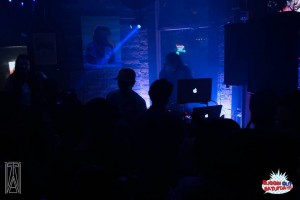
Che at night.
Photo used with permission from Che Burrito and Lounge, taken from https://www.facebook.com/photo.php?fbid=628625900503612&set=a.181112015255005.41659.129787013720839&type=1&theater
Site Analysis:
Upon entry to Che, the first thing one might notice is its quaint size for a club-type venue. There is one bar, located along the back wall, a few booths to sit at near the side of the venue, and a large space in the center of the venue meant for dancing. The spatial dynamics of this site are no doubt, meant to encourage dancing. I interviewed a young woman named Madison, who enjoys frequenting the venue during her time off school, whom also noticed this about the space. When asked whether she feels encouraged to dance while at Che, she responded with the following answer:
“Yes. There isn’t a lot of space that isn’t the dance floor. There are only a few booths with tables and a small space around the bar, so if you are there, you are most likely dancing.”
Being a relatively small venue, the dance floor fills up incredibly fast on Friday and Saturday nights, and patrons form a closely-knit group on the dance floor. Perhaps because of its quaint size, it was easy to experience a sense of connection to those surrounding me while at Che. I perceived that the small space enabled the atmosphere to seem busier, as well as more homey and comfortable – it invited people to come and dance. Keiran, a regular at Che whom I was able to interview, experienced similar feelings of connection while at the venue. He expressed that “[Che is] fun and you can definitely feel a connection through the music, whether you know the person or not.”
Upon my further inspection, the assortment of church pews lining the walls of the dance floor became apparent. These benches provided the perfect platform for more confident dancers – an opportunity for those willing to show off their moves. Julie, another Che patron I was able to interview, also noticed the importance of these benches in encouraging others to dance. She maintains that the benches act as a source of encouragement, not only for those who are confident enough to dance on them, but also for people who might be more reluctant to join:
“Nobody judges how you dance at Che. Everyone knows it’s the place to go and dance without feeling uncomfortable. There are church pews all along the perimeter of the dance floor, which not only provide unique décor but also are a place for people to get up and dance when they want to show off. When you see other people dancing, you want to dance too”
By way of exhibition, those who are brave enough to dance in front of a crowd, are able to encourage others to join in on the fun.
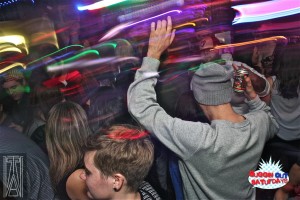
Dancers at Che.
Photo used with permission from Che Burrito and Lounge, taken from https://www.facebook.com/photo.php?fbid=500731913359389&set=a.500729120026335.1073741870.100002677531383&type=3&theater
The DJ booth at Che is located at the forefront of the dance floor. Directly below a colourful stained-glass window, and beside an eye-catching portrait of a raptor Jesus (yes, a dinosaur in the form of Jesus), the booth is front and center. This central location enables sound to permeate the entire environment. I had the opportunity to speak with Walter, one of the resident DJs of Che’s weekly Buggin Out Saturdays event, who explained that “the booth is the center of attention, which is perfect because Buggin Out Saturdays is a DJ-centric night.” Walter went on to say that the central location of the DJ booth “really helps the DJ and the crowd connect with each other.”
I also noticed that, like most other bar and club venues, the lighting was turned down at Che, and was replaced by technicolour, flashing lights. This added to the excitement of the venue, and fit with the upbeat music played by the DJs.
These physicalities of the space at 38 Hess St. S constitute what St John (2009) refers to as the “vibe” of the venue. The quaint size of the space creates a comfortable vibe in which patrons feel at ease. The placement of the church pews in the venue as dance platforms, further shapes the “vibe” of this location, as many of the people at Che I spoke with indicated that they provide a sense of comfort and simultaneous delight when danced upon. Along with the placement of the DJ booth and the lighting used at Che, the overall vibe of the venue is constructed for Che-goers to experience both individually and collectively. The vibe is shaped by “variables like location, fellow patrons, lighting, décor, costumes, and time of night or day, style of music, volume, tempos” (St John, 2009, 38.) It is in this way that the physical construction of space at Che may aid in the overall experience of the venue.
Many of the patrons I spoke with at Che were well aware of the ‘vibe’ that this space produced. The eclectic mix of music at Che delivers sets it apart from most other nightclubs on the block. Keiran, one of the regulars I spoke with, noticed the unique ‘vibe’ at Che and described it as “laid back, but still a party.” He explained that he liked Che better than most other bars and clubs in Hess Village because “people are still getting crazy and having fun, but it’s not swanky like the rest of Hess.”
It seems as though Che’s unofficial mantra is to be different, and they achieve this through their utterly unique ‘vibe.’ Unlike the rest of the clubs in Hess Village, which attempt to replicate the dance clubs of major cities and appeal to mass audiences, Che is not afraid to be different. Che doesn’t circulate the overplayed house music that every other venue on the street blasts through their stereos, nor do its DJs play the current Top-40, or what many of the patrons I spoke with deem “radio music.” Instead, Che’s DJs play a mix of different styles of music, which ranges from old school hip hop, to Motown classics, to indie-rock, to forward-thinking bass music and contemporary rap. Keiran recognizes this difference and relishes in the fact that his favourite bar plays music that is, in his own words, “not overly cheesy or fist-pumpy.” By playing such a heterogeneous selection of music, Che’s ‘vibe’ is both unique, and one of mass appeal.
Because of Che’s diverse music selection, it is able to attract people of various demographics and interests. Che gathers an eclectic crowd – a mixture of people from all different backgrounds, with different interests whom, however, all share a common love for music. Those which congregate this location, often form a unified mass – they are one with the music. Their ability to form bonds with fellow patrons, whether previously acquainted with them or not, is amplified through mutual enjoyment in the music and mutual participation on the dance floor. This is an idea similar to St John’s argument that people desire to be unified through music, that they “desire for a sacred sociality, a social warmth perceived to have been lost or forgotten in the contemporary world of separation, privatization and isolation” (St John, 2009, 38-39.) The sometimes nostalgic, but always heavily beat-driven music, and homey atmosphere provides a comfortable ‘vibe’, which welcomes anyone willing to give himself or herself in to the music.
Almost anyone can find a track throughout the night that they can personally identify with. Throwbacks, such as Motown hits and old-school hip hip tracks are particularly effective in bringing patrons together, inspiring them to form connections through their mutual enjoyment of the music. Madison notices that “a lot of the throwback music they play is well known, and the type you want to sing along to.” She claims that, in her experiences at Che, “it is not rare that you will see a group of strangers standing together, dancing and enjoying an old Jackson Five hit.” Cohen (1998) argues that “just one simple musical phrase can simultaneously represent a private world of memory and desire and a collective mood” (286.) Music can provoke particular emotions and memories (Cohen, 1998.) Through the frequent throwback hits played at Che, its patrons are able to satisfy their nostalgia, and tap into their memories. Playing an older tune most everyone is able to recognize has proven particularly effective for Che in producing strong emotional connections to the music amongst its visitors. This mutual enjoyment of the music experienced by people at Che exemplifies how music “draws people together and symbolizes their sense of collectivity and place” (Cohen, 1998, 273.) The always-danceable beats at Che stimulate movement and emotion, which “emphasize the intensity of experience evoked by music and its effectiveness in producing a sense of identity and belonging” (Cohen, 1998, 277.)
Although Che’s diverse musical selection has the ability to appeal to a wide range of people, I noticed a particularly prominent subculture in the venue. The crowd at Che, though diverse, was different from most other crowds among other bars in Hess Village because it attracts a particular subculture, which is usually disassociated from the typical dance club scene. The unique nature of the bar seemed to attract a group of people who appreciate its individuality and difference – those who strive to be different themselves. Che caters to a largely counter-culturalist or alternative subculture, more commonly known as hipsters. The music played at this venue differs from the more conventional club styles of music, garnering a more unique audience. This audience relishes in the distinct sound Che delivers – a fresh opposition to the Top 40 and bass-driven house music played by other clubs and bars in the surrounding area. Che’s resident DJ on Saturday nights, Walter, offered the following statement, which reveals how the music he plays attracts a different crowd from the usual run-of-the-mill nightclubs in Hess Village:
“A lot of ‘clubbers’ just want to hear their request, or the latest chart songs and don’t appreciate DJing, or most music in general, and that’s who the majority of promoters in Hess Village cater to. By not playing bad requests and keeping true to our vision, we have built a solid group of fun, appreciative regulars that trust us to handle the music… We want to give Hamiltonians a party with character, as an alternative to the dime a dozen club nights in Hess Village. After DJing for over a decade, we were sick of the same played-out music and the same played-out experience, and we wanted to bring forward a new groove to step to.”
For those interested, here’s a link to Che’s resident Buggin’ Out DJs’ soundcloud for an example of some of the music played at Che:https://www.soundcloud.com/bugginoutdjs
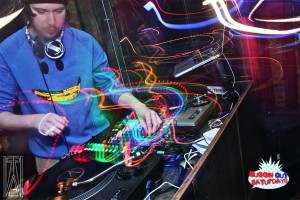
Buggin’ Out DJ, Walter, at the turntables.
Photo used with permission from Che Burrito and Lounge and Buggin’ Out DJs, taken from https://www.facebook.com/photo.php?fbid=500729633359617&set=a.500729120026335.1073741870.100002677531383&type=3&theater
In addition to the music played at Che, which works as what Hebdige (1979) would call a “signifier” of the hipster subculture, the location’s close relation to skateboard culture also acts as a signification of difference, of utter uniqueness from other club establishments. Keiran, a regular at Che and a skateboarder, explains his close relationship with the venue as it has always been a hub of hipster or skateboard subcultures. He said:
“I’ve actually been coming to this place before it was Che. It used to be DMBC skate shop. I bought my first skateboard here when I was a kid, and when Che opened, I bought my first beer here too.”
Through Che’s historical connection to a counterculture embraced by most of its patrons, it has become a representation of something more than a place – of a lifestyle that rejects the mainstream. Just as I did, Keiran notices that “there are lots of skaters and hipsters at Che.” He also recognizes music’s role in the construction of Che as a signifier of skateboard and hipster subculture in saying he believes these groups come here “because the owner is a skater, and the music played here is different.”
I was able to identify members of this particular subculture through their dress or their ‘hip’ style. Hebdige (1979) calls these identifiers the symbolic objects of the subculture. Their dress, language and music all work together to form a unity within the group’s realtions and experience (Hebdige, 1979.) Just as Hebdige (1979) argues that subcultures may employ particular styles of music as a signifying practice, the ‘hipsters’ of Che have employed Che’s unique musical selection as a representation of their own uniqueness, and a rejection of more mainstream forms of club culture.
The formation of Che’s distinct ‘vibe,’ in its application of diverging musical styles, uncommon décor, and manipulation of space, has led to Che’s wide appeal and, simultaneously, its utter uniqueness. Although attracting a particular subculture, which rejects convention, Che also has the ability to foster relationships between all different kinds of people through its music. Mutual enjoyment of the music played at this venue allows Che-goers to form bonds, regardless of their background or interests. Music is what connects these people is this space, and what constitutes this space is the music, which has brought these people together. It is in this way that sound has structured, or more specifically, music at Che has enabled the social production of place.
Citations:
1996/7. Hamilton City Directory, 199.
1997/8. Hamilton City Directory, 199.
2006/7. Hamilton City Directory, 893.
2007/8. Hamilton City Directory, 920.
Ballantyne, C. & Deans, W. Buggin Out DJs Soundcloud. n.d. Web. 25 Nov. 2013. https://www.soundcloud.com/bugginoutdjs
“Buggin Out Saturdays.” 9 Nov 2013. JPEG file. 4 Dec 2013. <https://www.facebook.com/photo.php?fbid=500731913359389&set=a.500729120026335.1073741870.100002677531383&type=3&theater>
“Buggin Out Saturdays.” 9 Nov 2013. JPEG file. 4 Dec 2013. <https://www.facebook.com/photo.php?fbid=500729633359617&set=a.500729120026335.1073741870.100002677531383&type=3&theater>
“Che Burrito and Lounge.” 30 April 2013. JPEG file. 4 Dec. 2013. <https://www.facebook.com/photo.php?fbid=571420609557475&set=a.553045444728325.1073741828.129787013720839&type=1&theater>
“Che Burrito and Lounge.” 2 Sept 2013. JPEG file. 4 Dec. 2013. <https://www.facebook.com/photo.php?fbid=628625900503612&set=a.181112015255005.41659.129787013720839&type=1&theater>
Cohen, S. “Sounding Out the City: Music and the Sensuous Production of Place” from The Place of Music, Leyshon, A., Matless, D., and Revill, G. (eds), New York: The Guilford Press, 1998.
D, Walter. Personal Interview. 30 Nov. 2013.
Davidson, M. “The Politicians Should Get Cracking on this Bold Idea”, The Hamilton Spectator. 10 July 1989. Print.
Hebdige, D. “Signifying Practice”, excerpt from Subculture: The Meaning of Style, Routledge: London 1979.
“Hess Village a Dilemma to City.” The Hamilton Spectator. 12 July 2007. Web. 27 Nov. 2013. <http://www.thespec.com/opinion-story/2149267-hess-village-a-dilemma-to-city/>.
McLorn, P. “Building World: A Trend Towards Shopping Villages – Hess Village”, Advertising World. N.d.
“NAMESAKES: Hess Street Stories behind local place names.” The Hamilton Spectator. 7 Jan 2013. Web. 21 Nov. 2013. <http://www.thespec.com/news-story/2267002-namesakes-hess-street/>.
“Ornamental iron inlay at Hess Village was rolled at Kubes Steel.” N.d. JPEG file. 4 Dec. 2013.<http://www.kubesteel.com/html/kubes_steel_aess_ornamental_inlay_hess_village.jpg>
R, Madison. Personal Interview. 2 Dec. 2013.
S, Keiran. Personal Interview. 20 Nov. 2013.
St John, G. “Neotrance and the Psychedelic Festival”, Dancecult: Journal of Electronic Dance Culture, Vol 1 (2009), No 1.
W, Julie. Personal Interview. 2 Dec. 2013.
Whitwell, C. “Staying Hot on Hess”, The Hamilton Spectator. 9 Aug 2008. Print.
